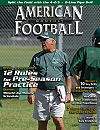Article CategoriesAFM Magazine
|
Tiger Training – Missouri’s 10 Key Defensive Line Drills and Techniques – How you can fortify your pass rush.by: Craig KuligowskiDefensive Line Coach University of Missouri © More from this issue The key to any defensive pass rush is putting pressure on the quarterback. Missouri conducts drills daily to At the University of Missouri, I have been very fortunate and blessed with defensive linemen who have and are embracing this attitude. In my time here, we have increased our sack total each year. We have had many players go on to All-Conference honors. We have had players lead the Big 12 in sacks and in tackles-for-loss. We have had a defensive lineman break the single game sack record, single season sack record and career sack record. We believe strongly in rushing the passer first. In order to be good on the DL, you must be aggressive. In order to be aggressive, you must be attacking. In order to attack, you must explode off the ball. You must attack with the....The full article can only be seen by subscribers.
|
|
|||||||
| HOME |
MAGAZINE |
SUBSCRIBE | ONLINE COLUMNISTS | COACHING VIDEOS |
Copyright 2025, AmericanFootballMonthly.com
All Rights Reserved





